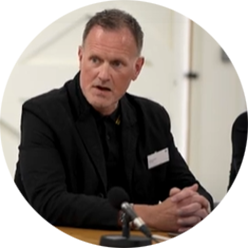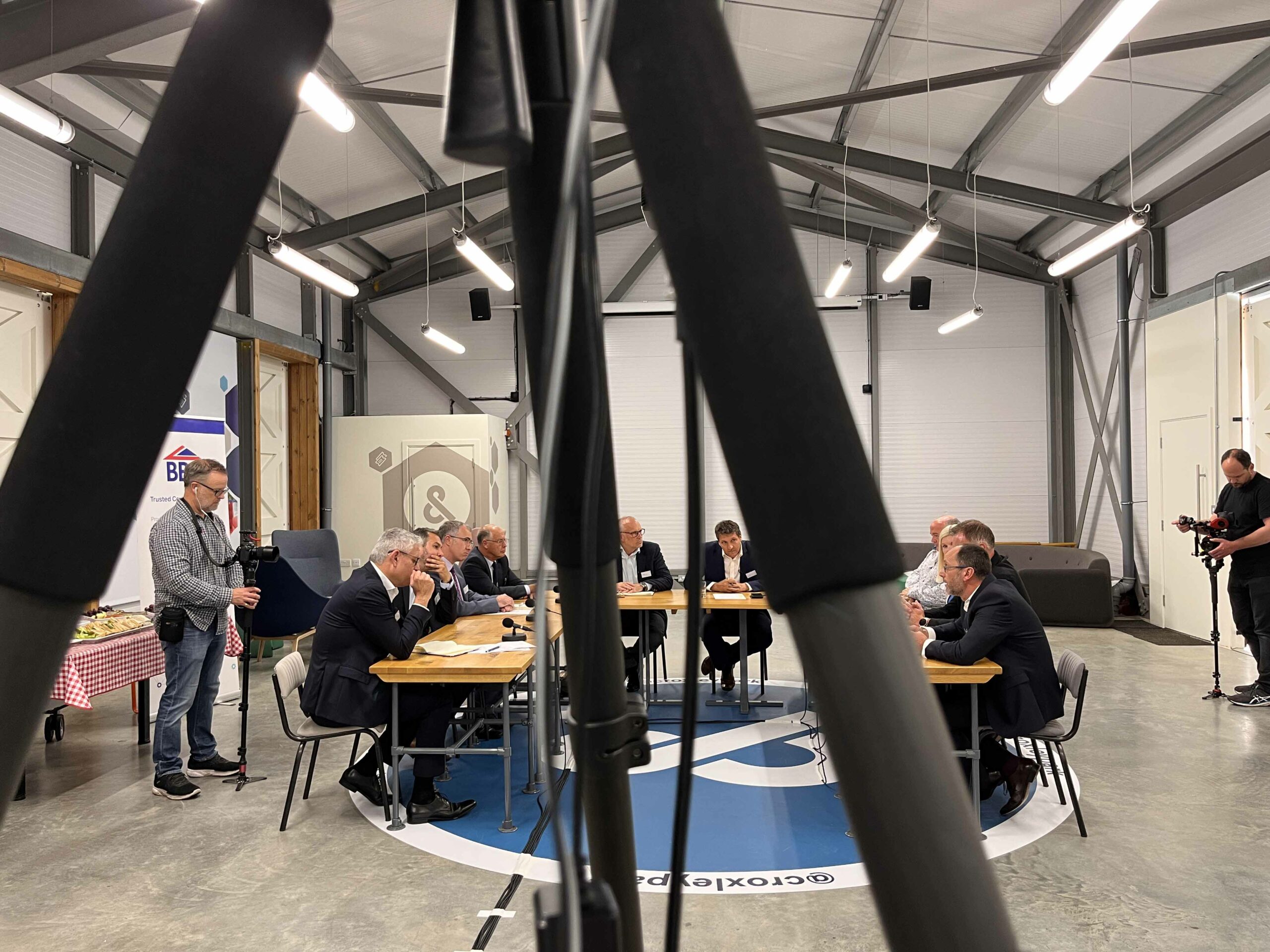Does the construction industry have the flexibility to adapt and evolve to deal with unforeseen external challenges and threats?
Does the construction industry have the flexibility to adapt and evolve to deal with unforeseen external challenges and threats? And if not, what needs to be done?
Speaking at the BBA’s Round Table discussion, Hardy Giesler BBA Chief Executive Officer, Richard Waterhouse BBA Non-Executive Director, Craig Smith Industry Lead / Convenor of City & Guilds, Jason Cureton Founder of Insulfix Ltd, David Johnson Technical Director of DGuage Ltd, Colin Johnson Managing Director of DGuage Ltd, Richard Smith Head of Products & Innovation of NHBC, Adam Turk Chief Executive Officer of Siderise Group Ltd, Antony Brophy Director of Business Development UK at CoBuilder and Emma Wiles BBA Sales & Marketing Director, shared their views.
Watch part 5 of 5: BBA Roundtable – Is construction flexibility enough to adapt to challenges?
Antony Brophy: CoBuilder
“The biggest challenges we have at the moment relates to materials shortage, labour shortage, challenges as a result of Brexit. When we look at labour-related items, there are conversations around quality, competency and workmanship. The challenges are can we get the right materials and can we find the right people to build to the right quality? From my perspective is the question around measuring the competence of individuals and companies doing the work? Is there a framework out there and what should that look like? It’s almost as if we need a CDM-type framework that speaks to competency”.

Richard Waterhouse: BBA
“Can the industry survive those threats? Yes, it can. Two years ago, we had Covid and the industry had to change the way it works, so obviously it can, but it comes at a cost. BCIS has just published their figures looking at inflation on materials, and it’s over 20% – double the rate of inflation for the economy as a whole. The problem is that we can adapt, but it will cost us in the long-run. It’s cost us people leaving the industry, it’s cost us productivity levels. The industry is capable of changing, and there will always be those organisations who are more agile and can see opportunity and are well-resourced to be able to capture those opportunities and move their businesses forward. But that’s only parts of the sector, not as a whole.”

Richard Smith: NHBC
“I think the key threats for us is the amount of regulatory change that’s going on at the moment, and whether we are able to keep up with that. History has told us that generally speaking, builders may think they will struggle with those changes, but when it comes to it, they are able to adapt. There’s a lot of concern about how it might happen, but when it does, we move onto the next part of the process. I think that the threats to the industry are with the demand of volume that exists; there’s always that challenge around cost, quality and capacity. The key thing is maintaining construction quality. The majority of new homes that are built, are built well. But for those that aren’t, how developers react to that is important. As an industry, we need to recognise that a consumer is a consumer, who is buying a property (sometimes their first).”

Emma Wiles: BBA
“It’s a crucial point for the construction industry at the moment. The fragmentation makes it difficult. From an outsider view, there is the ability to make a change, but it’s very much about driving focus and uniting as a sector to ensure that the approach is clear for everyone to get onboard with and make a change, rather than trying to do lots of different things separately. Relating that to Rail; similarly fragmented with lots of other challenges, because of the pandemic they are is in a situation where they have to unite the focus and together, jointly say what they’re going to focus on and change to ensure that the sector as a whole moves forward. The togetherness is the key to ensure that the industry adapts to change. Without that, it makes it really difficult.”.

David Johnson: DGuage
“We’ve demonstrated how we’ve adapted in the past, and to an unknown threat, when Covid appeared. We have, as a country and as a profession, survived it. Yes, there were those wounded along the way, but nonetheless, we’ve adapted. I think we need to differentiate between unknown threats and known threats. I think much of what we’ve spoken about are threats that we know about, and are threats to many industries – not just construction. The biggest one that we know about is the boom-and-bust cycle that we go through. There’s a purge on building something, and making something happen, and then in the next instance, there’s a tightening of the purse-strings. And it largely relates to political cycles. If we look at rail, the most successful projects we’ve seen are those that have been outside of the government turmoil cycle. We need to look at those and ask ourselves how we manage those and whether the people representing us doing the right thing in the sense that if our government wishes to see, for example, growth in housing stock, is the way it behaves in terms of supporting that industry correct? Are the ways that we need to address some of those threats actually upwards or downwards? Do we have the right people who are able to campaign on our behalf to ensure that we don’t see the boom-and-bust cycles, which are very destructive for any industry.”

Share This Story, Choose Your Platform!
Related Roundtables
Does the construction industry have the flexibility to adapt and evolve to deal with unforeseen external challenges and threats?
Does the construction industry have the flexibility to adapt and evolve to deal with unforeseen external challenges and threats? And if not, what needs to be done?
Speaking at the BBA’s Round Table discussion, Hardy Giesler BBA Chief Executive Officer, Richard Waterhouse BBA Non-Executive Director, Craig Smith Industry Lead / Convenor of City & Guilds, Jason Cureton Founder of Insulfix Ltd, David Johnson Technical Director of DGuage Ltd, Colin Johnson Managing Director of DGuage Ltd, Richard Smith Head of Products & Innovation of NHBC, Adam Turk Chief Executive Officer of Siderise Group Ltd, Antony Brophy Director of Business Development UK at CoBuilder and Emma Wiles BBA Sales & Marketing Director, shared their views.
Watch part 5 of 5: BBA Roundtable – Is construction flexibility enough to adapt to challenges?
Antony Brophy: CoBuilder
“The biggest challenges we have at the moment relates to materials shortage, labour shortage, challenges as a result of Brexit. When we look at labour-related items, there are conversations around quality, competency and workmanship. The challenges are can we get the right materials and can we find the right people to build to the right quality? From my perspective is the question around measuring the competence of individuals and companies doing the work? Is there a framework out there and what should that look like? It’s almost as if we need a CDM-type framework that speaks to competency”.

Richard Waterhouse: BBA
“Can the industry survive those threats? Yes, it can. Two years ago, we had Covid and the industry had to change the way it works, so obviously it can, but it comes at a cost. BCIS has just published their figures looking at inflation on materials, and it’s over 20% – double the rate of inflation for the economy as a whole. The problem is that we can adapt, but it will cost us in the long-run. It’s cost us people leaving the industry, it’s cost us productivity levels. The industry is capable of changing, and there will always be those organisations who are more agile and can see opportunity and are well-resourced to be able to capture those opportunities and move their businesses forward. But that’s only parts of the sector, not as a whole.”

Richard Smith: NHBC
“I think the key threats for us is the amount of regulatory change that’s going on at the moment, and whether we are able to keep up with that. History has told us that generally speaking, builders may think they will struggle with those changes, but when it comes to it, they are able to adapt. There’s a lot of concern about how it might happen, but when it does, we move onto the next part of the process. I think that the threats to the industry are with the demand of volume that exists; there’s always that challenge around cost, quality and capacity. The key thing is maintaining construction quality. The majority of new homes that are built, are built well. But for those that aren’t, how developers react to that is important. As an industry, we need to recognise that a consumer is a consumer, who is buying a property (sometimes their first).”

Emma Wiles: BBA
“It’s a crucial point for the construction industry at the moment. The fragmentation makes it difficult. From an outsider view, there is the ability to make a change, but it’s very much about driving focus and uniting as a sector to ensure that the approach is clear for everyone to get onboard with and make a change, rather than trying to do lots of different things separately. Relating that to Rail; similarly fragmented with lots of other challenges, because of the pandemic they are is in a situation where they have to unite the focus and together, jointly say what they’re going to focus on and change to ensure that the sector as a whole moves forward. The togetherness is the key to ensure that the industry adapts to change. Without that, it makes it really difficult.”.

David Johnson: DGuage
“We’ve demonstrated how we’ve adapted in the past, and to an unknown threat, when Covid appeared. We have, as a country and as a profession, survived it. Yes, there were those wounded along the way, but nonetheless, we’ve adapted. I think we need to differentiate between unknown threats and known threats. I think much of what we’ve spoken about are threats that we know about, and are threats to many industries – not just construction. The biggest one that we know about is the boom-and-bust cycle that we go through. There’s a purge on building something, and making something happen, and then in the next instance, there’s a tightening of the purse-strings. And it largely relates to political cycles. If we look at rail, the most successful projects we’ve seen are those that have been outside of the government turmoil cycle. We need to look at those and ask ourselves how we manage those and whether the people representing us doing the right thing in the sense that if our government wishes to see, for example, growth in housing stock, is the way it behaves in terms of supporting that industry correct? Are the ways that we need to address some of those threats actually upwards or downwards? Do we have the right people who are able to campaign on our behalf to ensure that we don’t see the boom-and-bust cycles, which are very destructive for any industry.”

Share This Story, Choose Your Platform!
Related Roundtables
Get in touch
Please complete the adjacent form and we will contact you as soon as possible.


